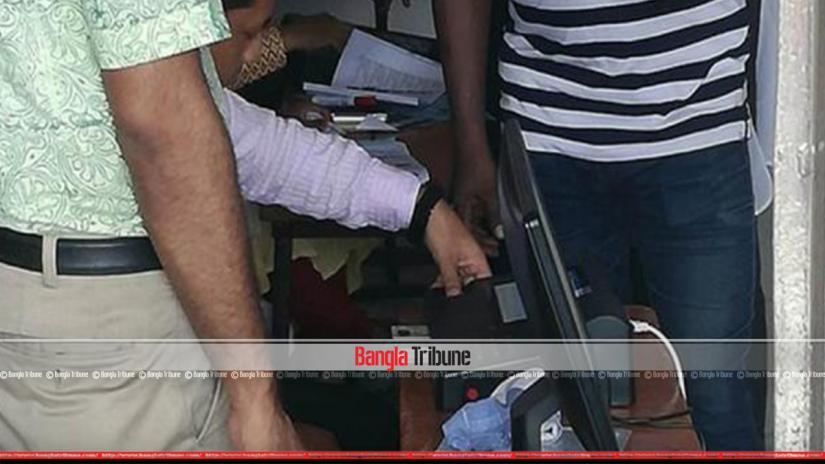 While the Bangladesh Election Commission has rolled up its sleeves to introduce electronic voting machines (EVMs) in the upcoming national election, neighbouring India has been using it for nearly the last two decades.
While the Bangladesh Election Commission has rolled up its sleeves to introduce electronic voting machines (EVMs) in the upcoming national election, neighbouring India has been using it for nearly the last two decades.
The e-voting experience in the world’s largest democracy is rather mixed with the opposition Congress calling to revert to ballot papers to ensure credibility to the election process.
Officials, who have been closely related to the election process, as well as observers also have mixed opinions but agree that EVMs effectively prevent booth capturing and ballot stuffing.
However, there are apprehensions among the political parties over the misuse of EVMs to manipulate the outcome.
Despite the allegations, India has exported its EVM technology to countries in Africa and Asia with some finding it convenient while at some places it created a furore.
Booth capturing and ballot stuffing
The 1994 Magura by-election during the BNP regime remains to be a glaring example of large-scale vote riggings in Bangladesh. And that was the case for elections in India, which has significantly come down after EVMs were introduced nearly 20 years ago.
“I can’t say about the technical details, but the best thing about EVM is once a vote is casted, it will take at least a minute to cast the next one. Even if that can be done, it’s easily detectable that whether the button was repeatedly pressed,” said retired bureaucrat Meera Pandey, who served as the chief election official for West Bengal.
“It’s impossible to cast hundreds of votes within 30 minutes, which happens during booth capturing, if EVMs are used. To be more specific, a booth, with 700 to 800 votes, has to be captured for the whole to rig the results, which is impossible now-a-days,” she told Bangla Tribune.
According to her, EVMS effectively prevents these types of riggings as well as expedites the vote counting process. Can EVMs be tampered?
Can EVMs be tampered?
The Indian political landscape is split over this specific issue with the opposition Congress calling to revert to ballot papers.
In a political resolution at the 84th Congress Open Plenary Session in March this year, the party said that voting and counting process must remain transparent to retain people's faith in the integrity of the electoral system.
"There are apprehensions among the political parties and the people over the misuse of EVMs to manipulate the outcome contrary to the popular verdict," it said.
It has been almost 20 years EVMs were introduced in India — first on a limited scale and gradually everywhere. After a decade, allegations of manipulating EVMs surfaced.
Political parties, except for the ruling BJP, across the country have been alleging that the EVMs are tampered in such a way that whatever the voters chose, it will always end up to BJP.
Last year, Aam Aadmi Party (AAP), which is in power in Delhi, staged a live demonstration of alleged EVM manipulation in the Delhi Assembly.
AAP MLA Saurabh Bhardwaj told Bangla Tribune then that anyone knowing a "secret code" can tamper with the EVMs and the code can be fed into a machine while casting vote.
According to Bhardwaj, the EVM has ‘tainted’ the world’s largest democracy and it should not be used anywhere in the world.
The Indian Election Commission, however, dismissed it saying the AAP used a prototype of EVM for the demonstration, which was not the one used for elections.
A few months ago, it organised a ‘hackathon’ challenging all political parties to hack the EVMs and claimed that no one was able to tamper with the EVMs. Indian EVMs abroad
Indian EVMs abroad
Amid allegations of tampering, India has exported its EVM technology to many countries in the world.
Several African and Asian countries have been sold the EVMs manufactured by the two state-owned entities— Bangaluru-based Bharat Electronics Limited (BEL) and Electronic Corporation of India in Hyderabad.
But the experience was mixed.
For instance, the African state of Namibia found it to be a success in 2014 as well as in the South Pacific country of Fiji.
But Indian EVMs caused a furore in the African nation of Botswana, where it faces question of credibility.
Diamond-rich Botswana is seeing heated political debates over using EVMs. The Opposition Botswana Congress Party (BCP) has moved court against the Botswana Democratic Party (BDP) government’s amendments to electoral laws that enabled the use of EVMs. BCP has contended that EVMs were aimed at getting a favourable result for BDP. The BDP government, in turn, has sought ECI’s deposition, even as the Botswana Independent Electoral Commission (IEC) argued that EVMs would speed up the electoral process.
Still, India has been in talks over the last few years to transfer its technology to several countries, including Sri Lanka, Mauritius, Philippines, New Guinea, Nepal, Kenya and Malaysia.
Earlier this year, Russia expressed its interest for using India’s EVM technology for its 2018 presidential election.
With the eleventh national parliamentary election looming, Bangladesh has approved a Tk 40 billion project to buy and maintain EVMs.
The Election Commission has forwarded the proposal to amend the Representation of the People Order (RPO) to use EVMs for the December election and has also sought approval for the project from the government.
The BNP and many other political parties are against the use of the EVMs in the election, while the ruling Awami League support the idea.
 Others
Others
31078 hour(s) 5 minute(s) ago ;
Afternoon 04:59 ; Friday ; May 03, 2024
EVMs: The Indian experience
Send
Ranjan Basu, New Delhi
Published : 00:07, Oct 22, 2018 | Updated : 23:46, Oct 22, 2018
Published : 00:07, Oct 22, 2018 | Updated : 23:46, Oct 22, 2018
0 ...0 ...
/zmi/
Topics: Top Stories
- KOICA donates medical supplies to BSMMU
- 5 more flights to take back British nationals to London
- Covid19: Rajarbagh, Mohammadpur worst affected
- Momen joins UN solidarity song over COVID-19 combat
- Covid-19: OIC to hold special meeting
- WFP begins food distribution in Cox’s Bazar
- WFP begins food distribution in Cox’s Bazar
- 290 return home to Australia
- Third charter flight for US citizens to return home
- Dhaka proposes to postpone D8 Summit
Unauthorized use of news, image, information, etc published by Bangla Tribune is punishable by copyright law. Appropriate legal steps will be taken by the management against any person or body that infringes those laws.
Bangla Tribune is one of the most revered online newspapers in Bangladesh, due to its reputation of neutral coverage and incisive analysis.
F R Tower, 8/C Panthapath, Shukrabad, Dhaka-1207 | Phone: 58151324; 58151326, Fax: 58151329 | Mob: 01730794527, 01730794528


